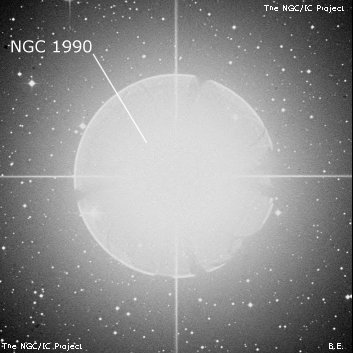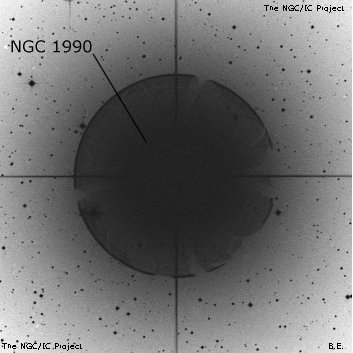NGC/IC Project Restoration Effort
(This is a very very beta version)
NGC1990


Basic Information
Location and Magnitude
Right Ascension: 5:36:12.8
Declination: -1:12:5
Constellation: ORI
Visual Magnitude:
Historic Information
Discoverer: Herschel W.
Year of discovery: 1786
Discovery aperture: 18.7
Observational
Summary description: !!!, eL, E, ε Orionis inv p
Sub-type: RN
Corwin's Notes
=====
NGC 1990. In spite of this nebulosity having been reported by WH, JH, and
Dreyer, as well as by several amateurs in recent years, there is no clear
evidence of it on photographs of the area. The images that do exist of the
nebulosity suggest that it could be a reflection nebula, shining by the light
of epsilon Orionis. If so, it will be very blue as epsilon is one of the
bluest stars in the sky.
Steve Waldee has brought this object back to my attention early in 2011, so I
am I reconsidering my earlier conclusion that the nebula is illusory. That is
still the best explanation for it, but here are some more thoughts about it.
WH says only of this nebula -- in the sweeps on 1 February 1786 -- only,
"[Epsilon] passed, and I am pretty sure is involved in Nebulosity, unequally
difused [sic]." CH adds the position of epsilon to the note, and that is the
one that JH and Dreyer have adopted for their catalogues.
JH has a little more detail from sweep 107 on 23 November 1827: "[Epsilon]
Orionis. Place by Catal a v brilliant * involved in an immense nebulous
atmosphere, whose n and s limits are 91[d] 7[m] 29[s] and 91[d] 31[m] 29[s].
Viewed also and shown to Mr. Dunlop in sweep 110 [16 December 1827]." That
much is from his 1833 catalogue in PT. Unfortunately, his notes on the object
(it is number 30) in the sweep itself are illegible, but he does have a
footnote, some of which I can make out. (JH's penciled notes will have to be
examined on his original pages to see what he actually wrote. The high-
contrast images in the Herschel Archives are very poor for many pages -- some
are essentially blank -- and often words on even the good pages are lost in
the photocopying process):
[Epsilon] Orionis is involved in a vast milky nebulosity which is something
of a lenticular [?] figure and is very much more condensed about the star
than elsewhere. [Illegible] to the two limits [illegible] but at the double
* it is [illegible] faint. [illegible] see it, he called it a star in a fog.
Other large stars have no such appearances[?]. [delta?] Orionis was free
from it -- The diffused light of the star (42a[?]) though considerable and
giving occasion to a singular [illegible] has[?] quite[?] [illegible] and no
way comparable to it.
From this, we can make out that he attempted to find the limits of the
nebulosity, that a guest observer also saw the nebula, and that other bright
stars in the area showed no such nebulosity.
In sweep 110, only part of JH's notes are legible: "Viewed [epsilon] Orionis
and the neb about it the neb is less[?] bright [illegible] than[?]
before[?]."
The conclusion is simple: JH saw the nebulosity on more than one night, and
it was seen by at least one other person than just him through his telescope.
A huge optical corona around the star from its scattered light (in the earth's
atmosphere, in virtually any telescope, on virtually any image) is inevitable.
This corona could well be hiding a nebulosity that is nevertheless visible, if
not easily, to the naked eye. Perhaps an image taken with the star blocked,
or carefully removed, would reveal a nebula close to the star similar to NGC
1432, NGC 1435, and IC 349 (all of which see).
JH noted that the nebulosity extends at least 12 arcmin north and south of
epsilon, while Dreyer (in the NGC Notes) makes it more extensive to the south.
On the POSS1 red plate, the star is apparently close to the center of an
extended, striated nebulosity. This, however, is not visible on any other
photograph or image that I've seen, including several color photos that would
certainly show a red nebulosity if it existed. This striation must be a
defect on the red plate, apparently caused by imperfections or reflections in
the red Plexiglass filter.
I certainly do not think that the nebula that the Herschels and Dreyer saw are
any of the more scattered nebulosities in the area. Not only are they too far
from epsilon Ori, but I doubt that any of them could be seen visually without
a nebular filter -- assuming it is emission nebulosity, of course. If it is
reflection nebulosity, a filter passing the oxygen and hydrogen lines won't
help.
So, at the moment, I'm doubtful about the existence of this object. But it
has been reported at the eyepiece often enough by reliable observers that it
could be easily lost in the light of epsilon Orionis. (In the table, I give
epsilon's position for this object.)
However, see NGC 7088 for a well-known case of an illusory nebula "seen" by
many experienced observers which is almost certainly non-existent.



